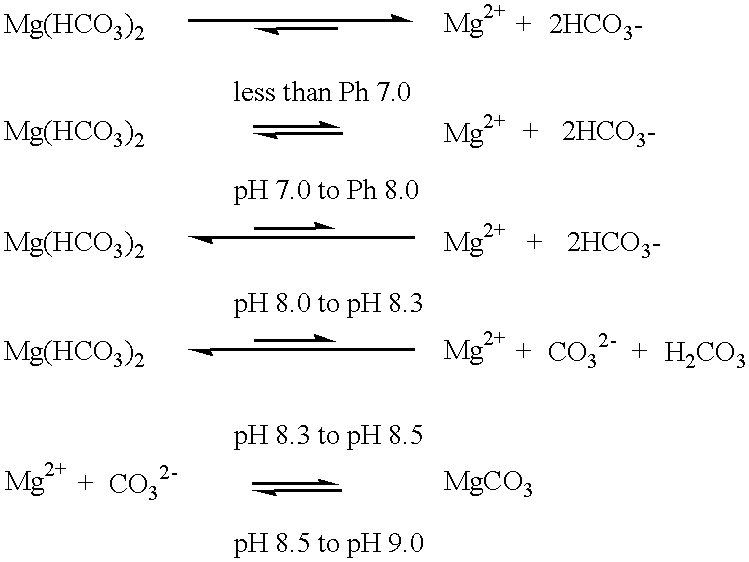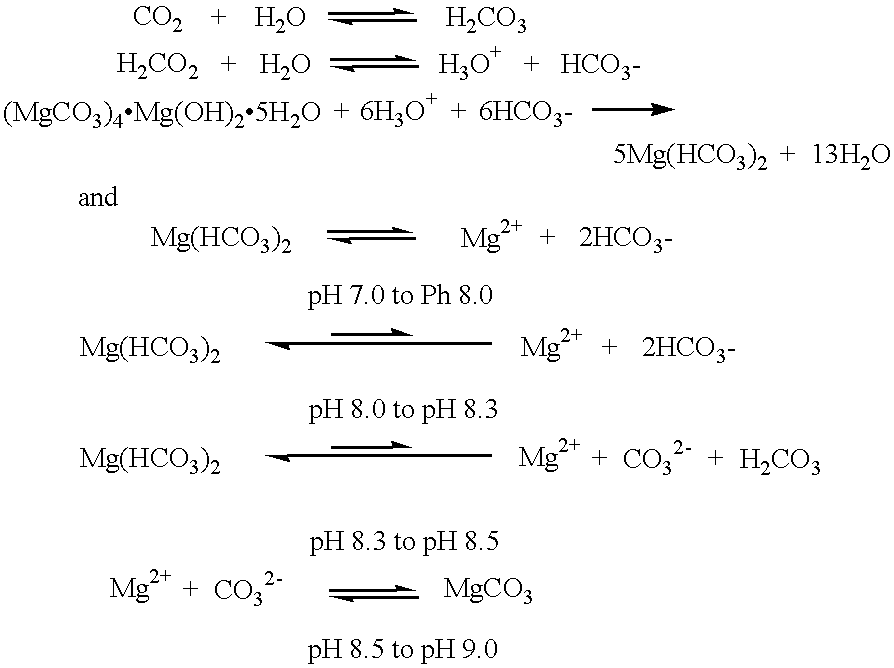Aqueous metal bicarbonate solution and method of use
a technology solution, applied in the field of aqueous metal bicarbonate solution, can solve the problems of severe side reactions, difficult to take preventative measures to avoid infection, temporary relief, etc., and achieve the effects of decreasing fatigue in a mammal, increasing motor activity, and increasing motor activity
- Summary
- Abstract
- Description
- Claims
- Application Information
AI Technical Summary
Benefits of technology
Problems solved by technology
Method used
Image
Examples
example 1
An Experiment to Decrease Intracellular Proton Concentrations and to Increase Intracellular Bicarbonate Concentrations in Mammalian Cells in Vitro
Aqueous bicarbonate anions act as proton sinks in the presence of excess proton concentrations in solution. This reaction can be represented by the chemical equation ##STR6##
In the presence of sufficient concentrations of bicarbonate anions, the reaction is essentially complete and proton concentrations decrease. The pH value of the solution increases. When plasma bicarbonate anions are present outside mammalian body cells in sufficient concentrations, they are translocated into the cytoplasm of the cells across the cell plasma membranes. Indeed, bicarbonate anions equilibrate rapidly across mammalian cell membranes. Bicarbonate translocation into cells takes place via several processes. These processes include a chloride-bicarbonate anion exchange and a sodium dependent chloride-bicarbonate anion exchange and potassium co-transport and ma...
example 2
An Experiment to Demonstrate Bicarbonate Anion Translocation from Aqueous Metal Bicarbonate Solution into the Mammalian Body Against a Bicarbonate Anion Concentration Gradient
Mammalian plasma contains bicarbonate anions at a concentration about 25 mmol (HCO.sub.3.sup.- 1,500 mg per litre). When ingested, aqueous metal bicarbonate solution produces biochemical, physiological and medical effects at bicarbonate anion concentrations about 16 mmol (HCO.sub.3.sup.-950 mg per litre). Aqueous metal bicarbonate solution, at bicarbonate anion concentration about 16 mmol, contains two thirds the bicarbonate anion concentration of plasma, so bicarbonate anions must be translocated into the mammalian body against a bicarbonate anion concentration gradient.
Mammalian plasma contains cations at concentrations around Mg.sup.2+ 24 mg per litre, Na.sup.+ 3,300 mg per litre, K.sup.+ 175 mg per litre and Ca.sup.2+ 100 mg per litre. Aqueous metal bicarbonate solution commonly contains cations at concentr...
example 3
An Experiment to Improve the Buffering Capacities of the Extracellular and Intracellular Bicarbonate Buffers and to Decrease Senescence and to Increase Longevity in a Representative Mammal
Mammalian body cells produce continuously concentrations of carbon dioxide. Upon hydration, carbon dioxide increases proton concentrations in the cytoplasm of body cells. The pH values of the cytoplasm of body cells are lowered. The production of protons in cytoplasm by the hydration of carbon dioxide can be represented by the following chemical equations: ##STR7##
The protons produced in the cytoplasm of body cells by the hydration of carbon dioxide, and other intracellular reactions, are buffered normally by intracellular bicarbonate buffers. The bicarbonate anions in intracellular buffers derive manly from the extracellular bicarbonate of blood plasma. The bicarbonate anions in blood plasma originate from erythrocytes as products of erythrocyte carbonic anhydrase enzyme reactions.
When plasma bica...
PUM
 Login to View More
Login to View More Abstract
Description
Claims
Application Information
 Login to View More
Login to View More - R&D
- Intellectual Property
- Life Sciences
- Materials
- Tech Scout
- Unparalleled Data Quality
- Higher Quality Content
- 60% Fewer Hallucinations
Browse by: Latest US Patents, China's latest patents, Technical Efficacy Thesaurus, Application Domain, Technology Topic, Popular Technical Reports.
© 2025 PatSnap. All rights reserved.Legal|Privacy policy|Modern Slavery Act Transparency Statement|Sitemap|About US| Contact US: help@patsnap.com



